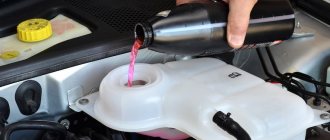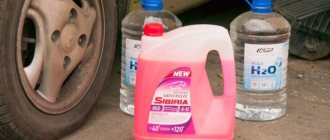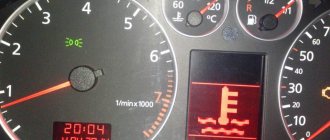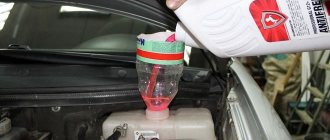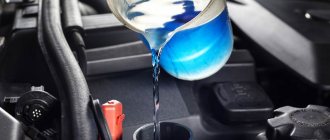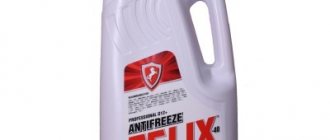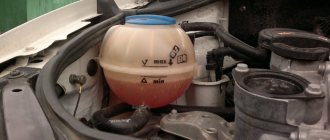The engine cooling system is an important component of the proper operation of the entire unit. As a result of using a car, it is periodically necessary to top up, and once every 3-5 years, completely change the coolant.
Coolant is available in two types:
- ready to use;
- concentrate.
Antifreeze in the form of a concentrate must be diluted with water before being poured into the radiator or tank. In its pure form, it is not intended for use as such; coolants with different freezing temperatures are prepared from it. There is one cooking method, the only difference is in the proportion depending on the desired operating temperature.
Antifreeze composition
The active substance in coolant is ethylene glycol. In the concentrate its content is 95-97%, the remaining 5-3% comes from additives and dye.
Antifreeze is colored according to three classifications:
- G11 – green, service life 3 years, used for all types of radiators;
- G12 – color from red to burgundy, filled in for a period of 5 years, carboxylate type additives, cover only corroded parts with a film;
- G13 – yellow, propylene glycol based, more environmentally friendly and expensive compared to G11, G12.
The latter is used in cars with forced engines, sports cars and motorcycles.
What to use for dilution
Everyone decides for themselves whether to use a concentrate or a ready-made composition. The convenience of its use speaks in favor of the second option. Be sure to keep a canister of coolant in your car. Deficiency, contamination and simply loss of your coolant can be one of the reasons for engine overheating. The consequences may be unpredictable, but certainly expensive to eliminate.
How to dilute antifreeze
Do not dilute the concentrate with tap water. It contains many impurities that can not only neutralize the protective properties of the liquid, but also harm the engine.
As a result of such an error, the small channels of the cooling system may become clogged, which will reduce its efficiency and also lead to corrosion of some engine parts.
To dilute the concentrate, only distilled water can be used. It is sold in hardware and auto stores, in canisters of various sizes at a low price.
Tips and tricks
To extend the service life of the cooling system, antifreeze must be selected correctly according to its properties and antifreeze must be replaced in a timely manner. Knowing how to dilute antifreeze concentrate and monitor the condition of the coolant in the cooling system also helps to avoid common mistakes:
- it is necessary to take into account in which climate zone the car is operated;
- Antifreeze concentrate should be diluted only with clean distilled water;
- periodically you need to check the density of antifreeze in the system;
We also recommend reading the article about why a car engine “boils” and overheats. From this article you will learn about the causes of engine overheating and ways to solve this problem.
Remember, the more water there is in the coolant, the higher the freezing point. However, increasing the amount of concentrate by more than 55% also does not allow obtaining high freezing resistance.
For this reason, it is necessary to dilute the antifreeze concentrate taking into account the proportions indicated on the package with the concentrate or in a special table.
Breeding rules
Before you start diluting the concentrate, you must carefully read the recommendations on the packaging. You cannot increase the proportion of water yourself, as this reduces efficiency. You also need to take into account the operating conditions of the vehicle and climatic conditions.
There are generally accepted proportions for bringing the liquid to working condition in the water/concentrate ratio:
- 7/1, freezing point -7, boiling threshold +100;
- 3/1, freezes at -15, boiling threshold +100;
- 1/1 freezing threshold -45, boils at +130;
- 2/3 freezes at -50, boils +150;
- 1/3 freezing threshold -70, boiling +170.
It is strictly forbidden to mix antifreeze of different colors.
How to check coolant density
The density of antifreeze must be calculated correctly. To do this, several conditions must be met. Firstly, it is important to maintain the temperature, which should be 20 degrees or close to it. If you measure density as soon as the car engine has been stopped, you will get incorrect data. Therefore, it is better to use a regular thermometer and check the temperature.
Secondly, a special device is used to determine density - a hydrometer. You can also purchase a more expensive device - a refractometer, but there is no point in overpaying for it. A hydrometer is a flask with a rod, on which, like on a thermometer, there are gradations. At the end of the meter there is a rubber or plastic pipette with which liquid is taken. The body of the device is made of transparent plastic or glass, so high temperatures are also not allowed when using it.
Antifreeze density is also measured as antifreeze, and is determined by the following method:
- Cool the engine to the required temperature of 20 degrees.
- Carefully open the expansion tank or radiator cap (depending on the type of cooling system design).
- Using a bulb located at one end of the hydrometer, collect the liquid.
- Place the hydrometer in a vertical position and secure it.
- Record the readings from the device.
If the data obtained differs greatly from the designations on the antifreeze label, then it is best to replace the liquid altogether.
To find out the density of antifreeze, the data table of which is presented below, you can use more modern hydrometers equipped with an additional scale that allows you to simultaneously measure the freezing temperature. In this case, you will not need to make any additional calculations.
| Ethylene glycol concentration, % | Mixture density, g/cm3 | Freezing temperature, °C | Ethylene glycol concentration, % | Mixture density, g/cm3 | Freezing temperature, °C |
| 26,4 | 1,0340 | -10 | 65,3 | 1,0855 | -65 |
| 27,2 | 1,0376 | -12 | 65,6 | 1,0860 | -66 |
| 29,6 | 1,0410 | -14 | 66,0 | 1,0863 | -67 |
| 32,0 | 1,0443 | -16 | 66,3 | 1,0866 | -68 |
| 34,2 | 1,0480 | -18 | 68,5 | 1,0888 | -66 |
| 36,4 | 1,0506 | -20 | 69,6 | 1,0900 | -64 |
| 38,4 | 1,0533 | -22 | 70,8 | 1,0910 | -62 |
| 40,4 | 1,0560 | -24 | 72,1 | 1,0923 | -60 |
| 42,2 | 1,0586 | -26 | 73,3 | 1,0937 | -58 |
| 44,0 | 1,0606 | -28 | 74,5 | 1,0947 | -56 |
| 45,6 | 1,0627 | -30 | 75,8 | 1,0960 | -54 |
| 47,0 | 1,0643 | -32 | 77,0 | 1,0973 | -52 |
| 48,2 | 1,0663 | -34 | 78,4 | 1,0983 | -50 |
| 49,6 | 1,0680 | -36 | 79,6 | 1,0997 | -48 |
| 51,0 | 1,0696 | -38 | 81,2 | 1,1007 | -46 |
| 52,6 | 1,0713 | -40 | 82,5 | 1,1023 | -44 |
| 53,6 | 1,0726 | -42 | 83,9 | 1,1033 | -42 |
| 54,6 | 1,0740 | -44 | 85,4 | 1,1043 | -40 |
| 55,6 | 1,0753 | -46 | 86,9 | 1,1054 | -38 |
| 56,8 | 1,0766 | -48 | 88,4 | 1,0660 | -36 |
| 58,0 | 1,0780 | -50 | 90,0 | 1,1077 | -35 |
| 59,1 | 1,0790 | -52 | 91,5 | 1,1987 | -34 |
| 60,2 | 1,0803 | -54 | 93,0 | 1,1096 | -33 |
| 61,2 | 1,0813 | -56 | 94,4 | 1,1103 | -32 |
| 62,2 | 1,0823 | -58 | 95,0 | 1,1105 | -28 |
| 63,1 | 1,0833 | -60 | 95,5 | 1,1107 | -27 |
| 64,0 | 1,0843 | -62 | 96,5 | 1,1110 | -24 |
| 64,8 | 1,0850 | -64 | 97,0 | 1,1116 | -22 |
If, before checking the density of antifreeze, you did not cool the car engine to 20 degrees, then the measured density, which is designated as t, can be brought to the required temperature using the formula:
P20 = Pt + γ(t - 20) ,
Where:
- P20 is a designation for the density of antifreeze at 20 degrees (usually indicated in g/cm3 in the table);
- Pt is the density of the refrigerant at the measuring temperature (measured in g/cm3);
- t is the actual coolant temperature at the time of measurement (indicated in the table as °C);
- γ – correction for the density of ethylene glycol (taking into account that for each degree there is 0.000525 g/cm3).
It is recommended to carry out such a check not only before diluting the antifreeze, but also simply to be sure that the cooling system contains liquid of the required density.
Well-known brands of antifreeze concentrate
Not all companies producing ready-made coolants produce antifreeze in the form of a concentrate. Among a small number of such manufacturers, the best are rightfully recognized:
- MOBIL ANTIFREEZE ULTRA - class G13, usually used in new premium cars, the finished liquid in a 1/1 ratio has a high boiling point, about +160 degrees and a low freezing point of up to -45. Service life is 5 years.
- LIQUI MOLY KUHLERFROSTSCHUTZ KFS 2001 PLUS - class G12+, the reliable composition of which has proven itself excellent among car manufacturers VAG, Mercedes-Benz, BMW. Service life is 5 years. According to the manufacturer, it can be mixed with class G11 on a silicate basis, but in this form the period is reduced to 2 years.
- CASTROL RADICOOL SF is a carboxylate antifreeze, class G12, which has proven itself positively among owners of diesel cars. Replacement interval 3 years. Disadvantages include high chemical activity.
- Motul Auto Cool G13 - based on monoethylene glycol with a package of organic and inorganic additives.
- General Motors - G12 concentrate has an extended replacement interval.
There are concentrated liquids developed and produced by domestic manufacturers, these include:
- Gazpromneft Antifreeze SF 12+ - based on ethylene glycol, for internal combustion engines, including stationary ones;
- LUKOIL ANTIFREEZE G12 RED – a protective layer appears exactly at the point of corrosion, increasing service life.
The choice of coolant should be made based on the recommendations of the vehicle manufacturer and well-established manufacturers. Particular attention should be paid to the originality of the product, so as not to buy a fake, purchase from trusted sellers or large shopping centers.
Liquid properties
Like any other liquid, antifreeze plays an important role for the full operation and protection of the system. During the warm season, the coolant keeps the engine from overheating, thereby allowing it to maintain its performance for a long time and slow down the wear process, and also contributes to its better performance.
Oddly enough, in winter the engine also needs cooling, because it heats up during operation, and it may boil. A normal temperature is 90−110 degrees Celsius. In general, three main functions of the anti-freeze can be distinguished:
- Cooling.
- Lubricant.
- Anti-corrosion.
Antifreeze concentrate is good in summer, but not suitable in winter, because the ethylene glycol it contains freezes at -13 degrees, and for the Russian winter this is a very low indicator. Therefore, in order not to have to take the car to a car service center, it is better to determine in advance how the antifreeze concentrate is diluted.
Light trailer Bee: technical characteristics, reviews, modifications
If you choose a concentrate, be sure to decide on the manufacturer and its type. There are compositions marked G11, G12, G13, the composition can be green or red. In order not to repeat myself, I suggest you read our material on mixing antifreeze, where you will get answers to all your questions. In the meantime, let's talk about an equally significant point, which concerns the preparation of finished cooling liquid based on a concentrated composition. After all, so much has already been said about dilution, but no one has yet answered with what exactly needs to be diluted.
Proportions
Usually the manufacturer himself indicates how and in what proportions dilution is carried out using strictly distilled water. There is a table on the label indicating all the parameters.
But it happens that there is nothing in the instructions, it has been erased or lost. Then you can build on the following recommendations. I will indicate the temperature range from the freezing threshold to the boiling threshold, and the proportions of water and concentrate that should be used:
- from -7 to +100 degrees Celsius - 87 by 13% (water and coolant, respectively);
- from -15 to +100 – 75 at 25%
- from -40-45 to 130-140 degrees - 50×50%;
- from -50-60 to +150-160 degrees - 40×60% (more concentrate than water);
- from -70 to +170 degrees – 25×75%.
In this case, the principle that more water makes the freezing point lower does not apply.
When diluting, be sure to use these proportions and do not violate the manufacturer’s recommendations. If you fill it with a lot of water, the properties of the coolant will be lost. Too concentrated a liquid can also harm the system and engine.
Percentage ratio when diluting liquid with distilled water
If you need to properly dilute antifreeze concentrate, then you should completely read the instructions, which are usually included with the packaging by manufacturers. In no case do not pour more water than necessary, because then the cooler will lose its properties. Don't forget about the climate conditions in which you live.
The table shows how to dilute antifreeze concentrate:
| Water percentage | Concentrate percentage | Freezing threshold | Boiling threshold |
| 87,5% | 12,5% | -7 | 100 |
| 75% | 25% | -15 | 100 |
| 50% | 50% | -40; -45 | +130; +140 |
| 40% | 60% | -50; -60 | +150; +160 |
| 25% | 75% | -70 | +170 |
Don't forget to take care of your car, because in winter it especially needs protection due to the drop in temperature. If you take into account all the recommendations about the method of using coolant and carefully read the label on the package, you will save yourself from constant major repairs of the car.
← Previous material
Next material →
What kind of UAZ Patriot tuning can you do yourself?
Sometimes it is fundamentally important what kind of car you have, Toyota, Ford, Volvo, Renault or a car of another brand. Each manufacturer uses a cooling system with certain parameters and components adapted to work with a specific type of coolant.
Before purchasing any liquid, check the instruction manual. As for popular and well-known concentrates, they include the following mixtures:
It’s up to you to decide whether to use Castrol or Total. The main thing is that the composition is suitable for your engine. Be sure to take this into account.
The choice of fluid for the cooling system is made based on the operating conditions and recommendations of the manufacturer of the engine, and not the coolant.
Subscribe to our website, leave comments, ask relevant questions and tell your friends about our project!
Source
Results
Is it necessary to mix the concentrate with the distillate? Yes, if we are talking about driving a car in harsh winter conditions. Traveling to hot places? In this case, you should not add water to the substrate, because the high operating temperature of the motor, coupled with the heat, will quickly put the engine out of operation, and having a maximum boiling point of 200 degrees is an excellent indicator of stability.
Another thing is that the cost of the concentrate is much higher than the finished product, so everyone decides for themselves what tricks to use in order to both save money and not subject the vehicle to increased loads on key power components. The situation is delicate and only experience will allow you to calculate the optimal dosage of distilled water in relation to antifreeze. Feel free to ask experienced car owners who will also be happy to share their skills.
